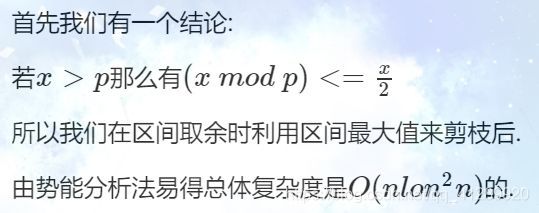【CodeForces - 438D】The Child and Sequence(线段树区间取模操作)
题干:
At the children's day, the child came to Picks's house, and messed his house up. Picks was angry at him. A lot of important things were lost, in particular the favorite sequence of Picks.
Fortunately, Picks remembers how to repair the sequence. Initially he should create an integer array a[1], a[2], ..., a[n]. Then he should perform a sequence of moperations. An operation can be one of the following:
- Print operation l, r. Picks should write down the value of .
- Modulo operation l, r, x. Picks should perform assignment a[i] = a[i] mod x for each i (l ≤ i ≤ r).
- Set operation k, x. Picks should set the value of a[k] to x (in other words perform an assignment a[k] = x).
Can you help Picks to perform the whole sequence of operations?
Input
The first line of input contains two integer: n, m (1 ≤ n, m ≤ 105). The second line contains n integers, separated by space: a[1], a[2], ..., a[n] (1 ≤ a[i] ≤ 109) — initial value of array elements.
Each of the next m lines begins with a number type .
- If type = 1, there will be two integers more in the line: l, r (1 ≤ l ≤ r ≤ n), which correspond the operation 1.
- If type = 2, there will be three integers more in the line: l, r, x (1 ≤ l ≤ r ≤ n; 1 ≤ x ≤ 109), which correspond the operation 2.
- If type = 3, there will be two integers more in the line: k, x (1 ≤ k ≤ n; 1 ≤ x ≤ 109), which correspond the operation 3.
Output
For each operation 1, please print a line containing the answer. Notice that the answer may exceed the 32-bit integer.
Examples
Input
5 5
1 2 3 4 5
2 3 5 4
3 3 5
1 2 5
2 1 3 3
1 1 3
Output
8
5
Input
10 10
6 9 6 7 6 1 10 10 9 5
1 3 9
2 7 10 9
2 5 10 8
1 4 7
3 3 7
2 7 9 9
1 2 4
1 6 6
1 5 9
3 1 10
Output
49
15
23
1
9
Note
Consider the first testcase:
- At first, a = {1, 2, 3, 4, 5}.
- After operation 1, a = {1, 2, 3, 0, 1}.
- After operation 2, a = {1, 2, 5, 0, 1}.
- At operation 3, 2 + 5 + 0 + 1 = 8.
- After operation 4, a = {1, 2, 2, 0, 1}.
- At operation 5, 1 + 2 + 2 = 5.
题目大意:
给一个序列
支持3种操作
1 u v 对于所有i u<=i<=v,输出a[i]的和
2 u v t 对于所有i u<=i<=v a[i]=a[i]%t
3 u v 表示a[u]=v(将v赋值给a[u])
n,q<=1e5 a[i],t,v<=1e9
解题报告:
这题需要维护最大值的,不能直接判断是否sum=0了就返回。因为我操作可能给的模数很大,如果我给1e5次这个大模数操作,那就n^2logn了,肯定炸,但是用判断最大值的的方法就可以取消一大部分操作使复杂度降回来。
AC代码:
#include
#include
#include
#include
#include
